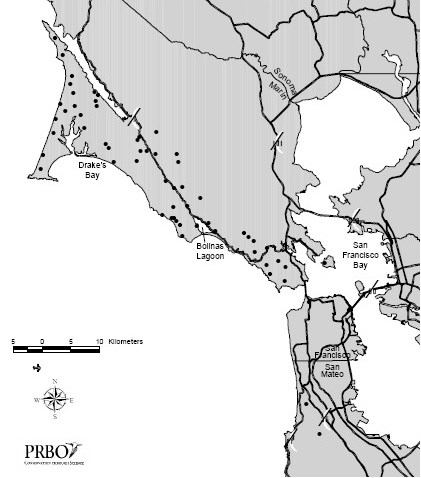Pied-billed Grebe
Ashy Storm-Petrel
Brandt's Cormorant
Double-crested Cormorant
Pelagic Cormorant
American Bittern
Great Blue Heron
Great Egret
Snowy Egret
Green Heron
Black-crowned Night-Heron
Canada Goose
Wood Duck
Gadwall
Cinnamon Teal
Turkey Vulture
Osprey
Northern Harrier
Sharp-shinned Hawk
Cooper's Hawk
Red-shouldered Hawk
Red-tailed Hawk
American Kestrel
Peregrine Falcon
Wild Turkey
California Quail
Black Rail
Virginia Rail
Sora
Common Moorhen
American Coot
Western Snowy Plover
Kildeer
American Black Oystercatcher
Heermann's Gull
California Gull
Western Gull
Common Murre
Pigeon Guillemot
Tufted Puffin
Rock Dove
Band-tailed Pigeon
Mourning Dove
Barn Owl
Western Screech-Owl
Great Horned Owl
Northern Pygmy-Owl
Northern Spotted Owl
Northern Saw-whet Owl
Anna's Hummingbird
Allen's Hummingbird
Belted Kingfisher
Nuttall's Woodpecker
Downy Woodpecker
Hairy Woodpecker
Northern Flicker
Pileated Woodpecker
Olive-sided Flycatcher
Western Wood-Pewee
Pacific-slope Flycatcher
Black Phoebe
Ash-throated Flycatcher
Hutton's Vireo
Warbling Vireo
Steller's Jay
Western Scrub Jay
American Crow
Common Raven
Horned Lark
Purple Martin
Tree Swallow
Violet-green Swallow
Northern Rough-winged Swallow
Bank Swallow
American Cliff Swallow
Barn Swallow
Chestnut-backed Chickadee
Oak Titmouse
Bushtit
Red-breasted Nuthatch
Pygmy Nuthatch
Brown Creeper
Rock Wren
Bewick's Wren
House Wren
Winter Wren
Marsh Wren
Golden-crowned Kinglet
Western Bluebird
Swainson's Thrush
Hermit Thrush
American Robin
Wrentit
Northern Mockingbird
European Starling
Orange-crowned Warbler
Yellow Warbler
Yellow-rumped Warbler
Black-throated Gray Warbler
Macgillivray's Warbler
Common Yellowthroat
Wilson's Warbler
Western Tanager
Spotted Towhee
California Towhee
Chipping Sparrow
Lark Sparrow
Savannah Sparrow
Grasshopper Sparrow
Song Sparrow
White-crowned Sparrow
Dark-eyed Junco
Black-headed Grosbeak
Lazuli Bunting
Red-winged Blackbird
Tricolored Blackbird
Western Meadowlark
Brewer's Blackbird
Brown-headed Cowbird
Hooded Oriole
Bullock's Oriole
Purple Finch
House Finch
Red Crossbill
Pine Siskin
Lesser Goldfinch
American Goldfinch
House Sparrow
Red-masked Parakeet


